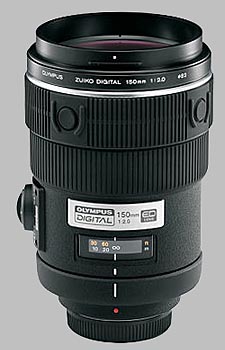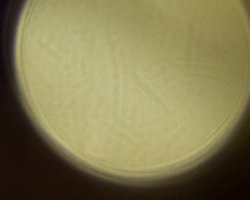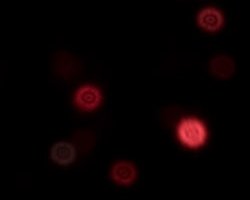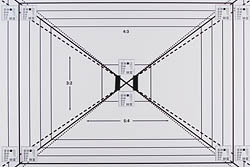| 150mm |
$2,801 average price |
|---|---|

|
|
Your purchases support this site
Buy the Olympus 150mm f/2 Zuiko Digital
Olympus 150mm f/2 Zuiko Gallery
Pairing a legendary lens with the PEN-F and the E-M1 Mark II
By Dave Pardue | Posted: 07/28/2017
The first time I laid eyes on the 150mm f/2 Zuiko lens I fell in love. Madly in love. I am not saying this to make this article sound interesting, nor would I even bother to write an article on a lens that's over a decade old in the first place if I was, indeed, not interested. The fact is that since joining IR 5+ years ago, I have been wanting to carve out some time to shoot extensively with this intriguing lens, and the PEN-F and E-M1 Mark II seemed like great reasons to finally pull it off the shelf and take it out for some quality shooting time.
(Note: Images have been resized to fit this page, cropped and/or altered in post-production, primarily to balance shadows and highlights as needed. Clicking any image will take you to a carrier page with access to the original, full-resolution image as delivered by the PEN-F or E-M1 Mark II. For additional images and EXIF data please see our Olympus 150mm f/2 Zuiko gallery page.)
1/1250s / f/2 / ISO 200 [Olympus PEN-F] |
We've long since reviewed this lens on the technical front, and that information is always valuable to check out for the critical details. The real world is of course the other half of the coin, so I went far and wide with this lens to bring you as much diversity as I could drum up. I chose to start with the capable PEN-F for portraits and later turned primarily to the E-M1 Mark II for trickier wildlife situations out in the elements. Both bodies proved capable companions for the 150mm f/2 Zuiko lens.
Olympus 150mm f/2 Zuiko mounted on the E-M1 Mark II / PEN-F standing by |
Long portrait shooting
The Olympus PEN-F was the first in the PEN line to come sporting an EVF, which really brought the camera much more solidly into enthusiast territory with the potential for a wide variety of shooting situations. And it's just a beautiful camera to look at as well, which isn't important to everyone but it is to some, myself most definitely included. I find it a beautifully crafted instrument and a joy to use in the field.
Is it a bit small to use with a lens as "stout" as the 150mm f/2, a lens originally designed for Four Thirds DSLRs. That does of course depend to a large degree on how you personally choose to hold your rig while shooting, and what subjects you're shooting. With a lens like this I tend to hold the lens itself a lot more than the camera, which I touch more for controls than holding. And this lens comes with its own tripod mount, although I shot virtually everything for this piece entirely handheld, as that's simply how I like to work for portrait shooting due to the inherent freedom allowed in the field.
1/2500s / f/2.2 / ISO 200 [Olympus PEN-F] |
The 300mm eq. reach of the 150mm f/2 Zuiko provides a generous amount of "compression" to an image, a visual perspective by-product of varying focal lengths due to the physical phenomenon known as perspective distortion. To a portrait photographer, the end result is that certain subjects often appear more flattering than they might with a wide angle lens, but the longer focal length also draws the background "closer" in to the subject, at least in visual appearance. This can often be either really cool or really distracting, and in practice simply becomes another tool in a photographer's toolkit, as well as something to be aware of. Personally, I find shooting portraits with longer focal lengths to be a great deal of fun.
1/8000s / f/2 / ISO 200 [Olympus PEN-F] |
One fairly difficult feat to pull off is shallow depth of field when you're *not* close to your subject. When you're close, and the background is distant, you can achieve greater subject isolation even with a good digicam. But if you're not close to your subject, and perhaps needing your subject's full body in the frame, and have a potentially distracting background or one you'd like to fade somewhat for separation, the trick is a lot tougher to pull off. The 150mm f/2 with its 300mm equivalent focal length has such an incredible amount of subject isolation potential when shooting wide open that your possibilities for curing the distracting-background-blues are somewhat elevated.
The call of the wild
This lens, like the lenses in the newer "Pro" line of M.Zuiko lenses, is dust and splash-proof. This bodes well for pairing it with our most recent overall choice for Camera of the Year, the Olympus E-M1 Mark II. Having very much enjoyed shooting with this camera now on many occasions, including several stints shooting it with the remarkable 300mm f/4 IS lens, I felt I needed not only the added weatherproofing but also the nice, deep grip as compared to the PEN-F while heading out into the wild for capturing more of the natural world.
A lens like this feels special to me, and forces me to try and rise to the occasion. It is not a subtle lens by feel in the hands, and the results it produces are not subtle either. It requires thought, some bicep strength for long durations, and some patience with the slightly slower AF speed due to the mount adapter. And yet, the results can often be outstanding and have a 3-dimensional presence about them, making the burden of the additional weight long forgotten.
As I was savoring the moment with the doe I was surprised to cross paths with a beautiful snake. He wasn't overly concerned with my presence either, and I suppose that's one of the joys of the state park system we have here in the US. The wildlife becomes somewhat accustomed to foot traffic, and generally isn't overly frightened. I was alone on the trail and treading lightly, and that tends to lend itself to the best chances for finding the more timid creatures of the wild. And a shallow depth of field is certainly a nice corridor for capturing a snake traversing.
After communing with the doe and the king snake, I headed to a local river to see what I might find along the banks. When I arrived at the edge of the river I saw nothing of immediate interest, but felt comfortable venturing into the river to knee-depth, given the entire rig is weather sealed. Before I was completely set in place a mother duck and her ducklings came ambling by, but they saw me before I could adjust and get a good shot. I was still able to squeeze off the shot below, which missed focus a bit (focused behind her tail instead of on her head). This was partially due to the somewhat slower AF speed, partially due to my not being fast enough on the draw, and partially due to them high-tailing it away from me. Yet again, the 300mm f/4 IS Pro would have been preferable in this particular situation.
I took the shot below not for artistic purposes but simply to give you an example of the "bokeh balls" from this lens while shooting wide open at f/2. Using tried and true stringed holiday lights at a distance of about 15 feet in the background, they give you an idea of what you can achieve in regard to this effect when desired, and to the relative character of the bokeh shape you can expect in general while shooting wide open.
1/200s / f/2 / ISO 200 [Olympus E-M1 Mark II] |
Bokeh: At f/2 the 150mm Zuiko can certainly lend charm to elements such as little holiday lights. |
1/4000s / f/2.5 / ISO 200 [Olympus PEN-F] |
150mm f/2: Mythical perception
Digital photographs are still not film. There is just something about film - the light rays sinking into an emulsion - creating an analogue of the scene itself. Fans of phonograph records understand the analog difference as well. Similar to how a fantastic microphone or an old tube preamp can help overcome the digital dread in the audio world, a terrific lens can assist with this concern in the photographic domain, and the 150mm f/2 Zuiko is just such a lens. There's magic in that mountain of glass poured inside, if you believe in that sort of thing.
Some do. I do. There's a difference, and it's hard to describe or quantify. Perhaps the best way to describe it in both the audio and video worlds is 3-dimensionality. But, regardless of whether there is indeed magic housed within, the lens is capable of capturing delightful images when paired with a competent imager like the PEN-F or E-M1 Mark II. And it can help overcome issues with distracting backgrounds as well, issues that would be much more pronounced and harsh if not for such a bright available aperture at your disposal.
Venturing into the etheric plane
I had a shot envisioned in my head, but was unsure how to best go about it. I wanted something from the etheric, something otherworldly. There it rustled about in my chaotic head until I started shooting with the 150mm f/2. For whatever reason, I felt like maybe it was time to try the crazy shot rumbling in my head. Is there some connection? Perhaps just a touch of madness in this particular expanse of glass?
1/1250s / f/4 / ISO 200 [Olympus PEN-F] |
Taos: Even when stopped down to f/4 this lens renders the distant background fairly smooth. |
A few more thoughts
As I was completing the shooting for this piece, I learned that Olympus would no longer be manufacturing 4/3rds glass, such as the 150mm f/2. This saddened me to some degree, but I was also bolstered by the fact that I'd been given the chance to shoot with this lens at all. At publishing time, there are still a few available to purchase new, so if you're interested this would be the time to acquire one. It's the brightest glass available for MFT shooters at the versatile 300mm eq. range by a full stop, and capable of astounding results.
I applaud the designers who created this lens, and the skilled artisans who sculpted it into life.
1/800s / f/2 / ISO 200 [Olympus E-M1 Mark II] |
• Olympus 150mm f/2 Gallery •
Olympus 150mm f/2 Review
(From Olympus lens literature) A high-performance telephoto lens that boasts high image quality and carrying ease. Extremely portable and designed specifically for digital photography - like all of its Zuiko Digital counterparts - this lens features a large maximum aperture of f/2 (perfect for low light situations as well) and both ED and Super ED glass lens elements for outstanding sharpness and color.
Introduction
At three and a half pounds, this lens is very large: in practice, you end up attaching the camera body to the lens, rather than attaching the lens to the camera body. The 150mm ƒ/2 is listed in the "Super High Quality" lineup, developed for more advanced optical/precision technology and exquisite picture quality. It's also listed as being dust and splash-proof, to allow usage in harsh conditions. The lens itself is comprised of 11 elements in 9 groups, with one ED ("extra-low dispersion") lens element and one Super-ED Available to offer sharper, higher-contrast imaging performance. Available for around $2,200.
Since Olympus digital SLR cameras employ the four-thirds imaging sensor, any lens attached to the body will have an effective focal length (in 35mm terms) of double the listed length. Thus, for this particular lens, it will exhibit an effective focal length of 300mm. The lens takes 82mm filters, and comes with several accessories: a giant bowl-style lens hood, a lens carrying case and a lens-collar tripod mount.
Sharpness
When you're looking to buy a lens of this caliber and price tag, sharpness, especially wide open, is critical. Looking at the blur graph, the lens delivers incredibly sharp results: from wide open at ƒ/2 to ƒ/11, it barely surpasses one blur unit. Diffraction limiting starts to set in at ƒ/16 where it hits 2 units on the blur scale, and by ƒ/22, the lens still produces very good results, registering just over 3 units (the odds are you wouldn't end up using this lens at ƒ/22 anyway). Overall, absolutely superb performance.
Chromatic Aberration
Resistance to chromatic aberration is superb. In the worst case at ƒ/11, it only ranks at just over 4/100ths of a percent. The lens appears to be specially tuned to its wider range of apertures, ƒ/2 and ƒ/2.8, where chromatic aberration is barely detectable. Exceptional.
Shading ("Vignetting")
Our vignetting chart shows a quarter-stop of light fall-off in the corners when shooting the 150mm at ƒ/8, but I had a hard time finding any practical evidence of it. At other apertures, there is no statistically signficant shading.
Distortion
Because the lens is fixed at 150mm, the distortion is also fixed. The maximum distortion is 0.25% pincushion (in the corners), where the minimum is distortion less than 0.1%. You would be hard-pressed to even notice this level of distortion, even when taking photographs of straight lines, and if it was a crucial issue, the image could be corrected in post-processing.
Autofocus Operation
The 150mm ƒ/2 Zuiko has quite a range of focus distance to cover, but it does so very quickly, racking through the entire range in just over one second. In practice, point-to-point autofocus was very quick when mounted on the E-510 body. There is some mechanical noise (a higher-pitched whine) during a full rack-focus, but point-to-point focusing is fairly subtle. With its fast ƒ/2 aperture, the 150mm macro performs excellently in low-light.
On the left side of the barrel there exists a switch to enable the lens to limit the range through which it will focus, with three options: infinity to 4 meters, 4 meters to 1.4 meters (its minimum focusing distance) and the full range of infinity to 1.4 meters. Obviously, you would move this switch off the default setting if you could guarantee you wouldn't need to focus outside of either of these ranges.
The 150mm ƒ/2 Zuiko is also equipped with four "focus-stop" buttons on the outside ring of the lens barrel. According to the manual, "by holding down one of the focus stop buttons, you can deactivate autofocus operation and fix focus at the point where the button was pressed." In practice, you would autofocus on your preferred subject as usual, and then you would have the option to recompose and maintain focus at your original focus point (the normal way you might do this would be to focus, adjust your focus operation to manual, then recompose).
Macro
With a close-focusing distance of 1.4 meters (just over four and a half feet) from the image sensor, the 150mm ƒ/2 is a poor substitute for a dedicated macro lens. At this range the lens achieves 26% image magnification when considered in 35mm film terms. An extension tube (EX-25) is available which extends this maximum image magnification to 31% (in 35mm film terms), and reduces the close-focusing distance to 0.79 meters (just over two and a half feet).
Bokeh
 |
| 150mm, ƒ/2 |
 |
| 150mm, ƒ/8 |
 |
| 150mm, ƒ/22 |
Build Quality and Handling
The 150mm ƒ/2 weighs 1,610 grams (56.7 oz, three and a half pounds), making it quite a hefty lens. It's put together well, with a combination of metal and plastic parts; the parts that see the most wear are metal, such as the filter ring and lens mount, while textured items such as the barrel and lens ring are a comfortable plastic. The focus ring turns with a silky smoothness, though it gets obscured when the lens hood is reversed for storage, making it obligatory to remove the hood for manual focus work. As with all Olympus "Super High Grade" lenses there is a focus range display. The lens hood looks to be particularly effective as preventing flare, given its size - over four inches deep and three and a half inches in diameter.
It is possible to shoot hand-held with this lens, especially with an image-stabilized body such as the E-510. However, this is a three-and-a-half pound lens we're talking about here; it is going to produce a fair amount of strain on the arm. The tripod mount is a high-quality piece, which be loosened to enable rotation of the body.
Alternatives
Sigma 150mm f/2.8 EX DG HSM APO Macro ~$540
This lens is the only real alternative for Olympus users looking for something with this focal length and constant aperture. The sharpness results for this lens tell the whole story; tack sharp almost all the way across from f/2.8 to f/22, neck-and-neck in terms of a comparison with the Olympus. Excellent results for chromatic aberration and distortion-free images; if we were splitting hairs, the Olympus distorts slightly more than the Sigma, but we're talking in the decimal points. Some slight vignetting at f/2.8 shows up on the Sigma, but mounted on a four-thirds sensor, you might not see this. With a much lower price tag, half the weight and the added bonus of impeccable macro performance, the Sigma 150mm f/2.8 is an attractive option, but you do get an extra stop of aperture with the Olympus.
Olympus 300mm f/2.8 Zuiko Digital ~$5,700
If you were looking at spending over two thousand dollars for a lens, perhaps you're in the market to spend over five? We haven't tested the 300mm f/2.8 from Olympus, but I can't imagine the results would be anything less than excellent.
Conclusion
There is no question that the Olympus 150mm ƒ/2 Zuiko is a well-built, high performance telephoto lens. The results from the labs show excellent performance across the board in terms of sharpness, resistance to chromatic aberration, distortion and vignetting. Of course, when paying over two thousand dollars for a lens, you should expect nothing less. The big question would be whether or not to consider the Sigma 150mm ƒ/2.8; it's much less expensive, but matches the Olympus in terms of quality. However, that extra stop of speed, and the high quality inherent in the Super High Grade lens lineup, would make the Olympus 150mm ƒ/2 an excellent addition to an Olympus owner's collection.
Sample Photos!
Sample photos are available of two laboratory test targets to help in our readers' evaluation of the lenses we test. The VFA target should give you a good idea of sharpness in the center and corners, as well as some idea of the extent of barrel or pincushion distortion and chromatic aberration, while the Still Life subject may help in judging contrast and color. We shoot both images using the default JPEG settings and manual white balance of our test bodies, so the images should be quite consistent from lens to lens.
As appropriate, we shoot these with both full-frame and sub-frame bodies, at a range of focal lengths, and at both maximum aperture and f/8. For the "VFA" target (the viewfinder accuracy target from Imaging Resource), we also provide sample crops from the center and upper-left corner of each shot, so you can quickly get a sense of relative sharpness, without having to download and inspect the full-res images. To avoid space limitations with the layout of our review pages, indexes to the test shots launch in separate windows.
To see the sample shots from this lens captured with this lens on our test body, just click on either of the thumbnails below, and scroll as needed in the window that appears.
Olympus 150mm f/2 Zuiko Digital
Your purchases support this site
Four Thirds - Black
Olympus 150mm f/2 Zuiko Digital User Reviews
-
• Incredibly sharp, corner-to-corner, at any aperture! • Buttery creamy bokeh. • Incredible subject isolation. • Can be a real deal these days (late 2019). • Fast and accurate autofocus, even without a modern voice-coil motor. • Close• Big and heavy. (But hey, it's ƒ/2!) • Subject distance is a bit too far for portrait work, and a bit too near for wildlife. Consider the 35-100/2 zoom for portraiture, or the 300/2.8 for wildlife.
When I first got this lens used from KEH.com, I could not take it off the camera! I know I looked like a dork, pointing it at everything in sight.
reviewed September 27th, 2019 (purchased for $828)
People react to it in a way they might not with a smaller lens, sometimes shying away, sometimes "puttin' on the Ritz," but they KNOW they are being photographed!
Don't get me wrong I love my small, lightweight Micro 4/3rds glass, but the "Little Tuna" screams "serious photographer!" Not that it's all that important, but if you are being hired, it does impress clients -- the results, even more so.
I've been hired to shoot an event later today. This one is going with me. -
extreme sharp, good construction, even very good with convertersno SWD-AF, cheaper plastics
very sharp - even with converters - much to like about it - but I would prefer SWD-AF
reviewed December 30th, 2012 (purchased for $2,500)
we will need this lens for mFT! -
F2.0, weather sealing, IQ, size, weightnothing really
Now, thats my lens. The 300 f/2.8 I can get for free when I need it.
reviewed September 15th, 2012 (purchased for $1,300)
Stellar performance. 300mm of reach with an aperture of F2 is really cool. Not speaking about the price I paid for.
After adjusting the Front-focus on my E-5, putting in -4, this lens performs outstanding. IQ is fantastic and AF is fast an accurate.
It size makes it very portable. I can put it side by side in my Lowepro Fastpack 350, with 12-60 and 50-200
I still got to test the EC-20. The EC-14 and the EX-25 is perfect match.
Gives you a great telemacro lens too.
Works well, but not as fast on the E-M5. Tested it on that one too. -
My favourite prime on FTNot the most sensible choice if you only need a 300 f/4 (see details)
I like super-long teles and I've also used the ZD 300 2.8 too but the 150 f/2 was a more satisfying lens to use for general shooting. Even the general apperance of the lens is great. The bokeh, sharpness and colours were all very very good. This would be the first lens I'd buy if I get a FT camera.
reviewed June 14th, 2010
All nice things aside, one still has to think about the practicality of such a lens. A 150 f/2 on a FT system is equivalent to a *300 f/4* (not a 300mm f/2) on a 35mm DSLR, both in terms of noise and DOF. If the buyer is not currently tied to the FT platform and just wants a stabilised 300 f/4, the ZD 150 f/2 is not a sensible option for the following reasons:
1. While there's no doubt about the image quality of the ZD 150/2, it is not better by a factor of approx 3.8x than a good 300/4 available for 35mm DSLRs. (The 35mm full-frame area is 3.8x larger than that of FT and so it is 3.8x less demanding in terms of spatial resolution). So a good 300 f/4 lens on a 35mm FF body will easily match or surpass the resolution of this lens at a much cheaper price. Demosaic'ing artifacts will also be much smaller on higher resolution FF images when final images are reproduced at the same size.
2. The lens is too big and heavy when compared to an equivalent lens on a 35mm DSLR.
3. The lens has no built-in image stabilisation or SWM despite point #2 above.
Conclusion: If you want this lens, by all means, go for it. You won't be disappointed. But if your motive is application-oriented and you have the freedom to choose another platform, go for a good, stabilised 300 f/4 on a FF body instead. -
Compact and light (when compared to 300mm f/2.8 lenses), beautiful bokeh, sharp wide openExpensive. No SWD version available.
There are certain lenses that can constitute a reason to own the accompanying camera system. This is one of those lenses. At under six inches in length and under three pounds it's about half the size of most 300mm f/2.8 lenses, as well as being a stop faster and providing excellent results wide open with the DOF associated with f/4 on a 35mm lens. Using the in-body image stabilization on my E-3 I can shoot blur-free photos with this lens at 1/30th of a second. A lens with this field of view should require shutter speeds starting at about 1/300th of a second, but the IS works like a charm. IMO there's never been a better lens for concerts, sporting events, plays and press conferences.
reviewed June 22nd, 2008 (purchased for $1,401) -
Fast lens with F=2, Very good optic quality, Fast AFHeavy and expensive but there is due to physical laws
A very good tele lens, high contrast and very sharp. Can be used with TC-14 and with TC-20 without visible loss in quality, even with maximum aperture! So you can get an very good 2,8/210 and a very good 4/300, too!
reviewed January 23rd, 2008





